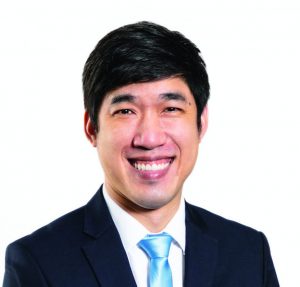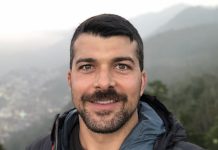What does Mooreast Holdings do?
Mooreast is in the business of providing mooring solutions to the offshore market, traditionally for the oil and gas industry. Mooreast systems are not the ones that are taken by the boats that go from place to place; ours are for permanent offshore infrastructures that need to be moored for 20 years, 25 years, 30 years, because that’s the requirement for the design of the float.
It needs to weather the worst-case scenario that happens in that location, since it does not have an engine for escape when bad weather comes in. That’s the context of the mooring system that we provide. We are one of three ultra-high holding power anchor designers in the world, and we are the only one in Asia. In house, we do a full suite from design, engineering, fabrication, installation, and we call this package a total mooring solution. We just recently got listed on the Singapore Stock Exchange on November 24 of last year. We are very excited to be in this space now with all the wind opportunities coming up.
So, what do we do? We provide a full suite of total mooring solutions, starting from the design engineering phase. Our core capability is actually in geotechnical and geophysical interpretation. We take the information — the soil, the wind, and the wave — figure out what the numbers are, and then translate it into a load, taking into account other data such as the shape of the float and project requirements to recommend a tailored size and number of anchors.
We do our own fabrication work in Singapore. Of course, in the mooring industry, there are other types of components — such as chains, wires, synthetic rope — and these are done by specialized manufacturers. We work together with them and integrate a full package and solution to the customer. A typical mooring requirement will start from the customer giving us geotechnical and geophysical information. They will tell us what sort of floater that they are using and ones they’re interested in using — What size? What are the dimensions?
What’s the shape? We run it through our analysis, and then we’ll come up with a solution such as how many mooring lines needed and what sort of equipment is available.
From there, we move into the supply phase — procurement as well as fabrication. This timeline typically goes from six months to a year of production, depending on how complicated it is. With the solution comes the installation phase — without a suitable installation vessel, it is actually a waste of money. You spend many days waiting and trying a very bad technique of installation.
However, leveraging our geotechnical interpretation capability — we call it a soft skill — we can design and supply the full suite of mooring subsea foundations best suited for the project, so we ensure we optimize the material costs and hardware requirements for the project, helping our customers to cut the cost in the installation phase.
We’ve been doing this for 27 years. We started floating wind in 2013, and our first project was the Fukushima Power Project.
What made Mooreast decide to explore renewables?
Our expertise is in providing mooring solutions to any type of floating structure in the market. And renewables are the natural progression as the market moves away from the oil and gas sector and into sustainable energy. Here in Southeast Asia, there is a very different market. It doesn’t have strong winds like the American, European, and North Asian market. We’re also working with solar and tidal energy sources at sea. This is where we also need to make the project economical so these projects can succeed. If we apply the same offshore standard to wind as the oil and gas industry is taking, these projects will never come to life, and we’ll have less customers to service. Our interest is in providing the best fit-for-purpose solution to these customers, whatever the infrastructure that they’re working on, and allow them to succeed in the business that they have.
Is this why you’re pursuing the floating offshore turbines because of the nature of the wind where you’re at?
Yes. For example, Japan doesn’t have an offshore market, and the reason for that is that they do not have the people and the talents that understand how to handle offshore work. They do not have the engineers that know how to design offshore works. They have civil engineers, and so we come and we support them from an early stage where they are conceptualizing. We may not understand the turbine, but based on the structure that they give us, the center of gravity that they give us, we can help them to design a mooring system that is suitable and within their budget range.
What high-profile projects have you worked on?
The Fukushima Power Project was probably the most prominent project that we have serviced. This started when the Fukushima tsunami incident happened, and the nuclear power plant was affected. And because of this incident, the Japanese government wanted to reduce its dependence on nuclear facilities, and offshore wind was the natural first option that they looked into. Japan, because it is facing the Pacific Ocean, the shoreline drops sharply very close to the water, so they do not have a lot of land that is available for fixed foundation wind, and, therefore, they have to explore floating wind.
How has Mooreast been able to capitalize on experience with other offshore industries to prepare for renewables?
The oil and gas has been on a downturn for the past eight years; yet, during this time, Mooreast has actually been expanding. We have been increasing our vertical scope of supply. Previously, we were only a product supplier and didn’t have a full in-house capability to do design engineering. This was incorporated in 2015, 2016, and then we also increased our capabilities to support installation work. When we are doing design, we have to keep in mind what the installation is going to look like in order to make the project work well. We have been through many cases where the designers do not understand the installation, and as a result, they come up with a specification of products that are not easy to install offshore and which result in a burst of the budget, which is not pleasing to any customer.
Because the opportunity for wind involves multiple turbines in one location, it’s different from the oil and gas market where it is one floater for one project, so there needs to be a way to make the project efficient and optimize. This comes down to every single detail such as the sizing of the anchor. Our anchors are actually designed to hold 80 times their weight, which means to say a 10-ton anchor can hold a maximum of 800 tons of force.
This is where we come into play, especially for offshore wind, because it needs to be optimized, and it can be very easy. You only need a 10-ton anchor while others are supplying a 30-ton anchor. This is a very costly exercise, and it may not be economical for the wind industry.
What makes Singapore ideal for renewable development?
The first thing that make Singapore ideal is actually the offshore experience. Singapore has been in the offshore and marine market for many, many years, and because of that, it has the ecosystem and it has the talents to provide this sort of offshore work. Mooring is only one part of the many components required in the offshore supply chain.
How much of Mooreast’s business does it expect to generate from renewables?
We see an exponential growth, but at an early stage, we are expecting about 50 percent of our revenue to be in renewables in about two years’ time. This is conservative in my opinion.
And this is a realistic estimate, but the estimates are driven by the project — how we see the project developing. And of course, at this moment, the market is in the fixed-foundation stage where they do not require floating infrastructure. But we see that already being discussed by many developers across many countries such as Japan, Korea, Taiwan, Scotland, U.K., France, and Denmark. We see all these projects gradually taking shape, and we expect to have a very busy second half of the decade.
What kind of challenges do you see Mooreast facing in order to grow and evolve with the renewable sectors and how might those challenges be addressed?
During the downturn in the oil and gas, we see a high attrition of capable people within our market. And this is not only in Singapore; we no longer see younger college students pursuing an interest in the global oil and gas sector. But the fortunate thing is that, throughout the years, Mooreast has been evolving and remains profitable because of our lean size. We have managed to solve this problem internally, but generally as a market, we see that this is an issue.
We hope that with the renewable energy — and a lot of younger people are very into this sustainability trend — we hope that this sustainability trend will continue to attract these younger people and being part of a renewable energy generation is one avenue where they apply themselves. They can actually do something to help to steer the world away from having a heavy carbon footprint with more sustainable energy sources. This is a visible avenue for younger blood to come and join us.
More info mooreast.com































